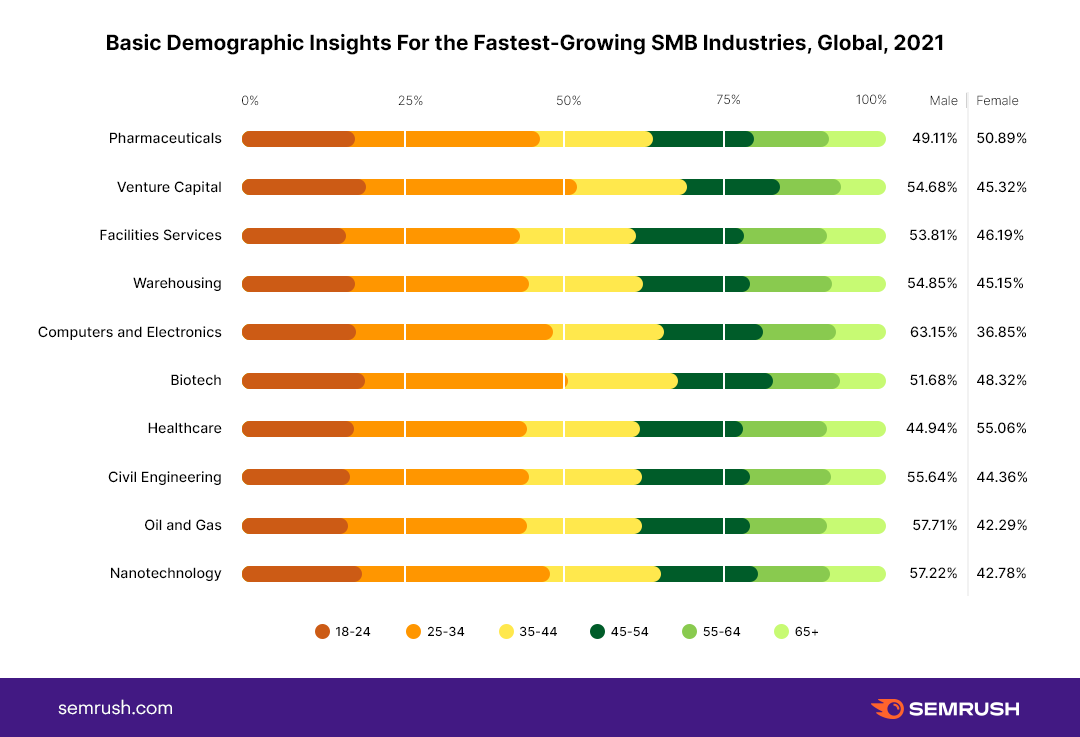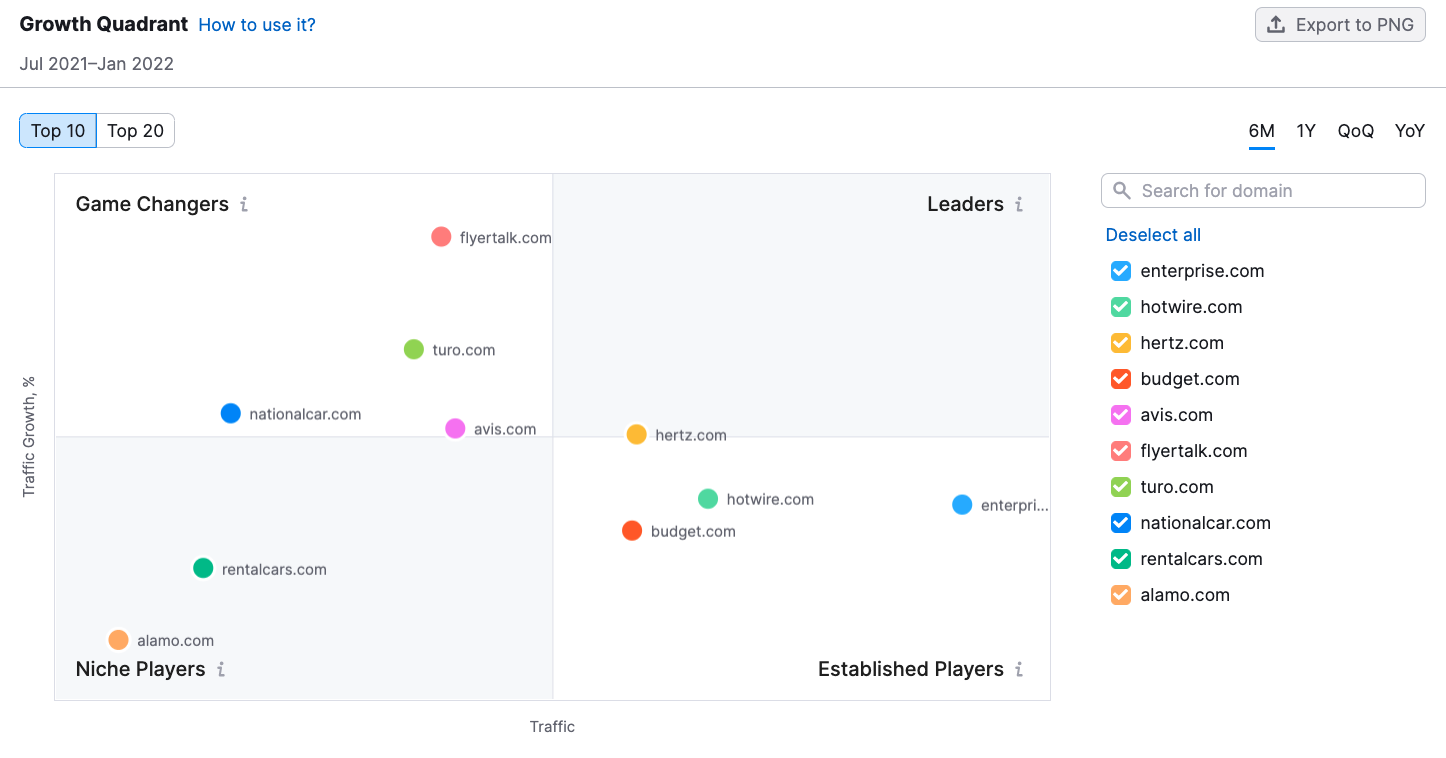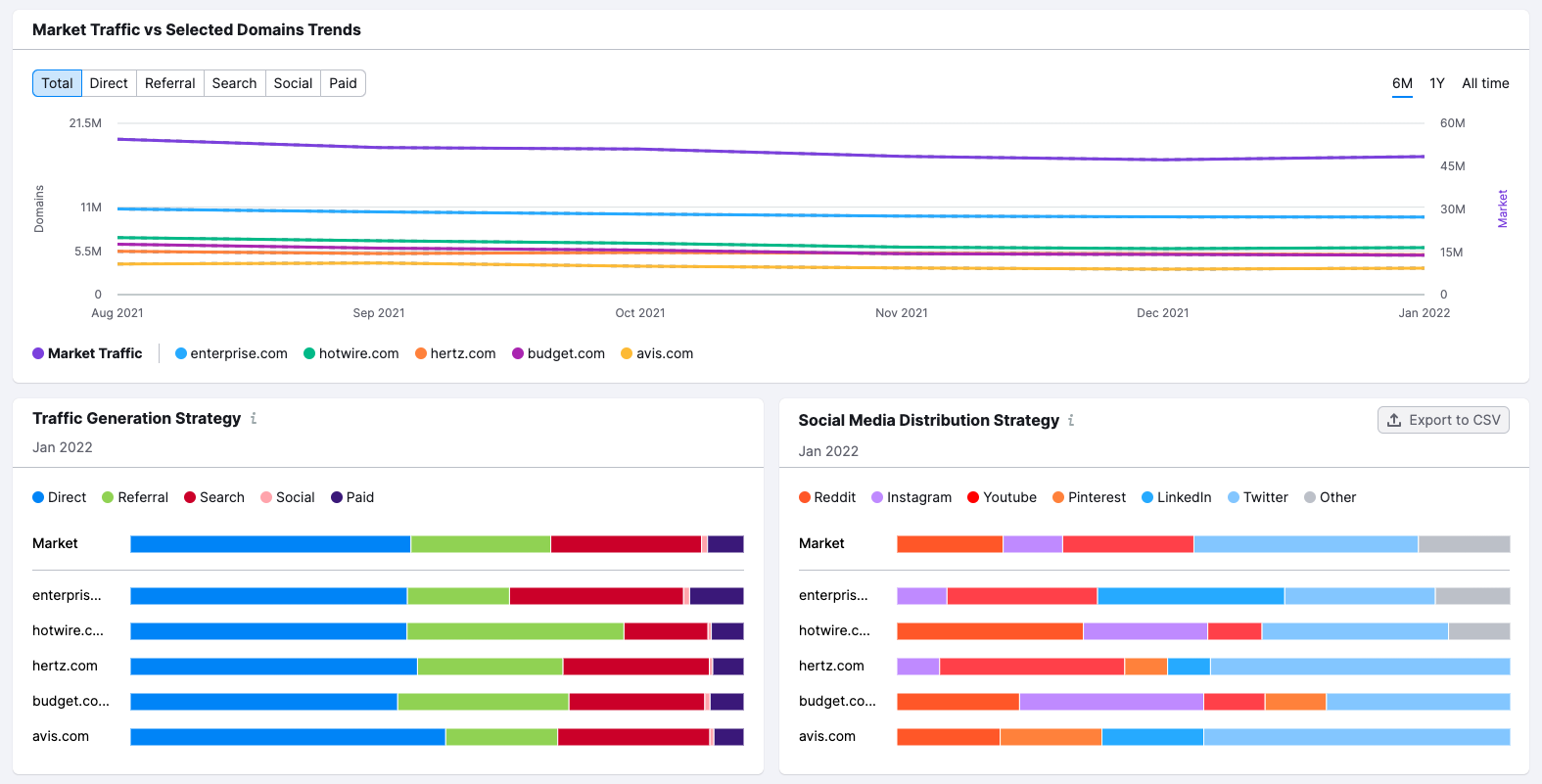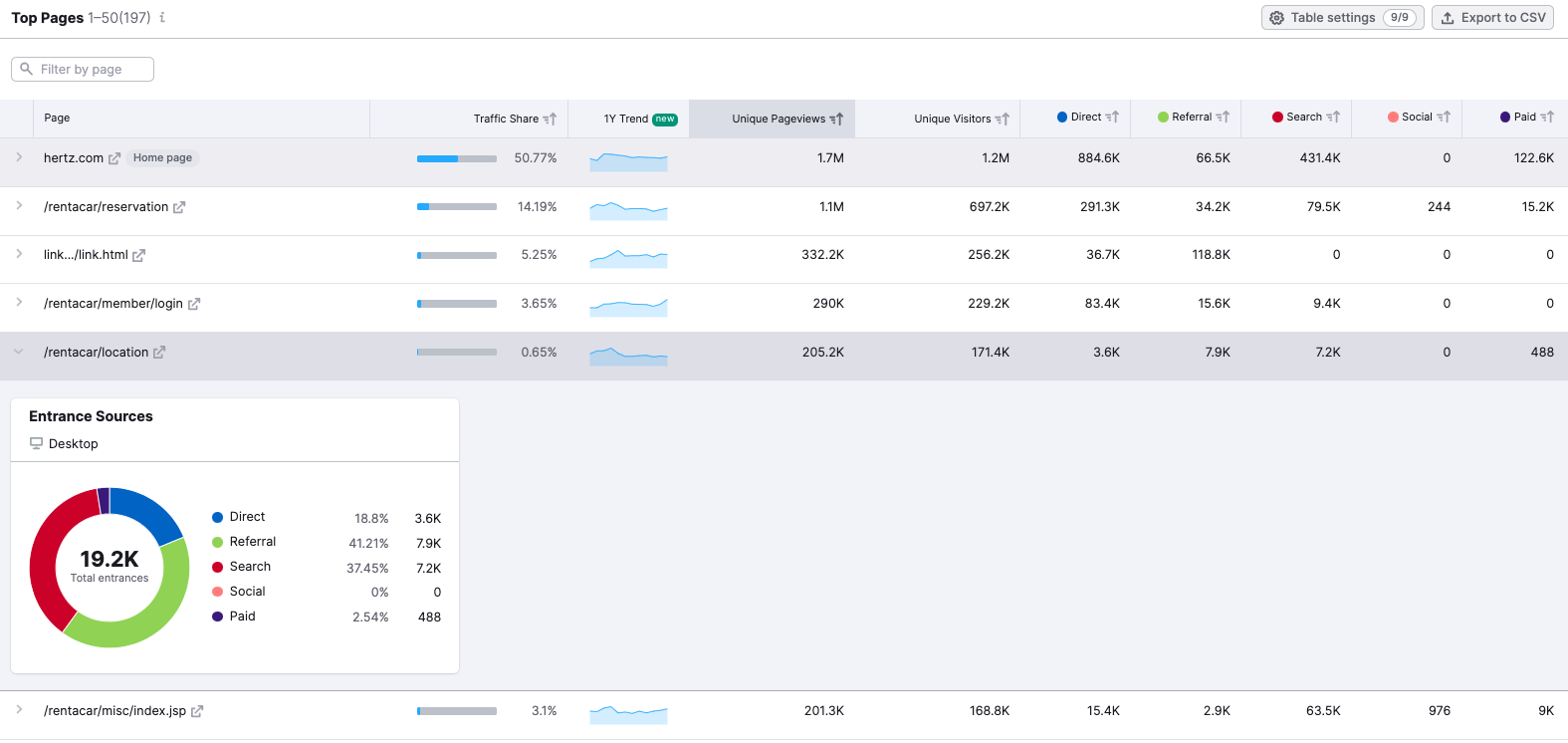Every marketer (analyst, researcher, etc.) knows that solutions offering competitive intel typically have more extensive data coverage for larger sites.
While you definitely want to get insights about the top market players in your niche, no competitive and market analysis is complete without a proper look at smaller brands.
After all, a niche player today could be the industry game-changer of tomorrow. Consider Tesla, initially an outsider brand, they’ve gone on to reshape the face of the automotive industry and are now the sixth company in US history to hit the $1 trillion market cap.
That’s why we’ve decided to look at the fastest-growing industries within the small-to-medium segment for the past few years — to see where their growth drivers come from and pinpoint their key market traits.
About the Study
Taking OECD’s small-to-medium business criteria as the guiding principle to define SMB brands, we’ve made sure all the sites within our scope of analysis belong to companies that have:
- Up to 500 employees;
- From $500K to $10M in annual revenue.
We then used company information from Crunchbase to get a scope of 150,000 sites that are all a part of the global SMB segment.
To run this study, we’ve turned to our .Trends solution to analyze global traffic and growth patterns within these 150,000 domains since the early start of the pandemic, from 2019 up to now. Without any further ado, let’s look at the fastest-growing industries in SMB and unwrap their key characteristics.
The 10 Fastest-Growing Industries in SMB Since the Pandemic
Our analysis showed that throughout 2021, site traffic within the SMB segment increased overall. But some industries demonstrated more prominent growth patterns:
The 10 Fastest-Growing Industries in SMB, Global
| # | Industry | YoY traffic growth |
| 1 | Pharmaceuticals | 406.18% |
| 2 | Venture Capital | 405.90% |
| 3 | Facilities Services | 384.14% |
| 4 | Warehousing | 305.85% |
| 5 | Computers and Electronics | 284.88% |
| 6 | Biotech | 222.67% |
| 7 | Healthcare | 220.38% |
| 8 | Civil Engineering | 216.41% |
| 9 | Oil and Gas | 153.49% |
| 10 | Nanotechnology | 149.64% |
If you’re wondering how these verticals managed to grow so quickly, we suspect the pandemic itself played a major role.
Growth here seems to be aligned with the pandemic’s supply chain disruptions that led to skyrocketing prices for commodities and consumer goods, the unprecedented focus on medicine and healthcare, and, of course, the financial market boom.
The Top 5 Most Visited Websites within Each Industry
Now that we understand the picture on an industry level, let's take a more nuanced look and see which individual sites were growing the fastest within each analyzed industry.
For a better understanding, we’ve stacked the top 5 SMB sites* that were growing at the fastest rate within the industries up against the top 5 sites by overall traffic across the entire industry and compared their growth rates.

If we take out two exceptions, on average, the 5 fastest-growing sites within the analyzed industries were growing 420 times faster than the key industry players.
Only Venture Capital and Nanotechnology sites showed a counter-trend where leaders witnessed more prominent growth:
- The average traffic growth for the fastest-growing Venture Capital sites was at 3000%, while the key players were growing at 6000%.
- For Nanotechnology sites, the average growth rate was at 1300%. In the meantime, industry leaders saw a whopping 51000% traffic increase.
As we mentioned, all the analyzed industries appear to be linked to the so-called pandemic effect. But there is one notable trend among healthcare and biotech-related sites — most of the fastest-growing sites, even within the SMB segment, seem to be connected to genetics and genome studies.
This, in turn, might once again be linked to the pandemic as many people got more familiar with genome sequencing — something scientists rushed to do and media covered at the very beginning of the pandemic. As for genetics, genetic tests potentially owe their growing popularity to some alleged talks about the existence of genetic predisposition towards COVID.
*Please note that sites that make it into the top 5 fastest-growing categories were typically pretty small back in 2019. If we exclude one large venture capital site (carrd.co), the average traffic back then was at 52,000 monthly visits. So this notable growth, sometimes at thousands of percentage points, is also the result of the fact that most of them started small.
Key Demographics of the Top 10 Fastest-Growing Industries in SMB
We’ve decided to look at some basic demographic insights to see if growth might somehow be related to the kinds of audiences these industries target:
- If they all attract similar audiences, this might imply that the reason behind growth lies within the fact that a certain demographic has become more active online since the pandemic.
- If not, well, that just means that we should take a closer look at other growth drivers.

Sex-wise, the breakdown is more or less 50/50 across most of the industries, with a few exceptions:
- Civil Engineering, Oil & Gas, Venture Capital, Nanotechnology, and Computers & Electronics verticals show a more prominent male audience.
- Healthcare appears to attract a larger share of the female audience.
When it comes to age, all the industries that were growing the fastest during the pandemic show an identical pattern:
- 25-34-year-olds are the largest demographic that making up around one-third of these industries’ audiences.
- 18-24 and 35-54-year-olds have similar audience shares and together make the second-largest demographic.
Audience size significantly drops when we look at people aged 55 and more.
Where Does this Growth Come From?
As we saw some uneven patterns within the demographic stats, we kept digging to see where these industries’ main growth drivers were. To do this, we took a close look at their traffic sources.
Traffic Channels that Bring the Most Visitors
Of course, the first stop was to analyze traffic channels that are ‘responsible’ for bringing the largest shares of audiences across the industries.
When you go through the channel-by-channel breakdowns for each industry, keep in mind that each traffic source we cover here often implies the following trends in marketing strategy:
- Direct traffic often means that the website has high brand awareness (users simply type in the brand name into the search engines) and loyal audiences (people bookmark the site if they visit it pretty often).
- Search traffic means that the site has great visibility across Google and is doing a good job at SEO.
- Referral traffic shows that the brand likely invests in original content (has a lot of other sites linking back to it) and smart spot-on marketing partnerships.
- Social traffic implies that the brand has a successful presence across various social media channels and knows how to convert its social users into site visitors.
- Paid traffic, as you’d expect, indicates that the company invests in advertising and these efforts pay off as they manage to drive audiences back to the site.

Six out of ten industries get the majority of their traffic from direct search. This means that sites within the Oil & Gas, Computers & Electronics, Warehousing, Facilities Services, Pharmaceuticals, and Healthcare industries tend to have widespread brand recognition.
But there are a few notable trends when we look at the breakdown by traffic sources:
- Organic Google search is the second-most impactful channel when it comes to traffic. Only the Biotech and Civil Engineering industries managed to unleash the full power of organic search and have it as their main traffic source.
- Referral traffic has a solid presence across the key traffic-driving channels. It typically comes in second or third. Nanotechnology sites have referral as their main traffic source, with 51% of all visitors coming from external links. Sites within the Computers & Electronics and Outsourcing industries are also more reliant on referral traffic than the rest.
- Social appears to be the least impactful traffic channel, with a curious exception of the Venture Capital industry where 45% of all traffic comes from social media. Either companies within the rest of the industries don’t invest in their social media presence, or it’s simply not a channel with a lot of traffic-driving force for these industries.
Social Media Platforms that Bring the Biggest Impact
It was interesting to see that social media somehow makes less traffic impact than paid search. Despite this, as social media implies a large variety when it comes to platforms, we’ve decided to explore which social media networks appear to be most impactful in terms of their traffic-driving power.

Among all social media networks, Facebook looks like the key traffic driver for the fastest-growing industries in SMB.
We’ve also spotted an interesting discrepancy between the top three most common platforms in terms of presence and the top three most influential platforms in terms of traffic-driving potential:
- YouTube, Facebook, and Reddit appear across all the industries, with the only exception of Nanotechnology, which only has four key social media channels — Facebook (70%), and LinkedIn, Twitter, and YouTube.
- But if we look at networks that on average bring in the largest share of audiences across all the analyzed industries, we’ll see a different picture — Facebook comes first (70% of all instances), YouTube second, and...LinkedIn comes third.
- LinkedIn is within the top three most impactful social media platforms across the Biotech, Healthcare, Oil & Gas, Nanotechnology, and Pharmaceuticals industries.
On top of the names that you’d expect to see from the analysis of the social media platforms that bring in the highest traffic shares, we’ve also noticed a few less conventional networks that drive more or less notable traffic shares for some industries:
- Windows Live Spaces, Microsoft-owned blogging and social media service, brings the highest audience share (from social, of course) to sites within the Computers & Electronics industry.
- Computers & Electronics sites generally show the widest mix of social media channels that range from Flickr and Foursquare to Xing and MySpace.
- Sites within the Venture Capital industry are generally showing unusual patterns in regard to their social media success: Twitter comes as the top source of social traffic, followed by Instagram and Tumblr. You’ll also see the likes of Gaia Online and Last.fm among their social media mix.
- Biotech sites get traffic from some field-specific social media platforms like Geni.com and MyHeritage.
Overall, our social media-related traffic analysis shows that depending on the industry, the social media platform mix varies, and sometimes significantly, and some industry-specific networks hold a significant audience potential.
How to Keep Watch on the Smaller Players in Your Industry
Depending on your industry and particular niche, the range of players to watch out for will vary significantly. While these kinds of studies do offer some great insights into the latest market trends, you have to go granular when collecting data for your own competitive and market analysis.
So here are the key three steps to take to keep a close eye on the competition. We’ll walk you through the workflow using the Semrush .Trends platform as it delivers in-depth insights even on sites within the SMB segment.
1. Identify potential underdogs
When it comes to competitor monitoring, not every site deserves your attention. Use the Market Explorer tool to reveal the key industry players — from market leaders to game-changers, and pay special attention to the latter.

The tool defines game-changers as sites with smaller market shares but the highest growth rates, so these are your industry’s potential underdogs you should watch out for.
2. Keep watch on general market trends
Before deep-diving into each game-changer’s success strategies, take a quick look at the traffic generation strategies within your entire industry — to revisit your own if you spot some emerging growth/decline trends across various channels.

3. Unwrap which digital strategies trigger game-changers’ growth
Turn to the Traffic Analytics tool for a more detailed analysis of their traffic acquisition strategy.
On top of audience insights, traffic journeys, and much more, the tool reflects the most visited pages which point to the most popular products or content. Review the game-changers’ top pages and explore which channels bring in the most traffic to their most popular assets, and take note for your own product and promo tactics.

